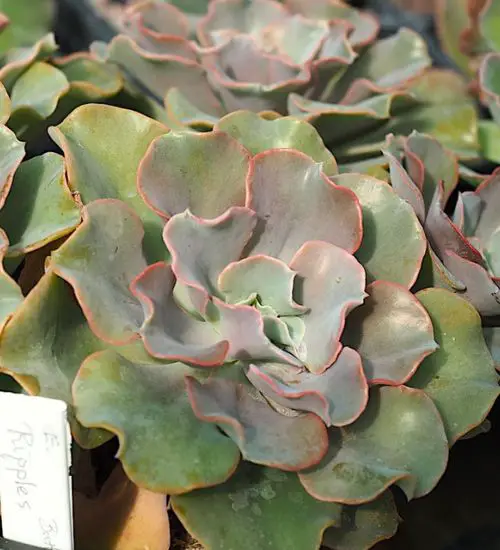Sun: full sun to partial shade
Water: Typical water needs for a succulent
Temperature: Zone 9b from 25° F to 30° F (-3.9° C to -1.1° C) to Zone 10b from 35° F to 40° F (1.7° C to 4.4° C)
Winter Survival: Not cold hardy
Propagation: leaves, stem cuttings
Flower:
Flower Type: Unknown - Tell us
Toxic: Generally non-toxic to humans and animals
Dormant: winter
Space Requirement:
Common Problems:
Where to buy Echeveria ‘Ripples’?
Basc Care for Echeveria ‘Ripples’
Watering
Regular watering period should be every 2 weeks
One simple tip for you is that you can use some online apps to check the soil status before you go water your succulents. I would recommend the ThePlantsCheck app, it has some nice features there.
Fertilizing
Only feed this succulent during its active growing seasons which means winter. Use the right fertilizer applied in the right amounts. Applying half-strength balanced fertilizer every month or so is recommended for optimal results.
Do not fertilize during winter as the plant is dormant.
Sun & Location Requirements for "Echeveria ‘Ripples’"
Echeveria ‘Ripples’ requires full sun to partial shade in order to stay healthy and vibrant. Always keep an eye on the temperatures and light levels as too much direct sunlight can be damaging to this type of succulent. If you notice any signs of distress, try moving it to a shadier spot within your garden or home.
As per this succulent profile, it is only able to stay healthy when the environment temperature is above the range of zone 9b from 25° F to 30° F (-3.9° C to -1.1° C).
When temperatures drop below freezing, it is important to take precautions to protect Echeveria ‘Ripples’ from the cold. Insulating and providing adequate drainage for the plant are key elements in helping it survive winter weather. Wind and sun exposure should also be minimized to prevent frost damage.
Echeveria ‘Ripples’ also benefits from some indirect light throughout the day as well, so make sure you give it enough space to soak up light without becoming too exposed to heat.
Propagation
Propagating succulents from leaves is an easy and cost-effective way to grow new plants. All you need are a few healthy leaves from the mother plant, some potting mix, and regular watering. After a few weeks you'll have brand new succulents that you can watch grow!
Successfully propagating succulents is a great way to increase your collection of these unique houseplants. To propagate Echeveria ‘Ripples’ by stem cuttings, you’ll need a few supplies including a sharp, clean knife and soil.
Toxicity

Echeveria ‘Ripples’ is generally thought to be non-toxic for humans and animals. However, it is important to note that certain parts of the plant may contain toxins which can cause mild skin irritation if ingested or touched. For this reason, the plant should always be kept away from children and pets.

